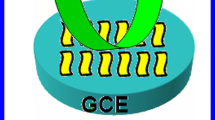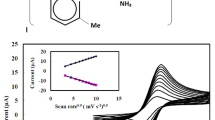Abstract
Shuttle-like copper oxide (CuO) was prepared by a hydrothermal decomposition process. The resulting material was characterized by scanning electron microscopy and X-ray diffraction. It was then immobilized on the surface of a glassy carbon electrode modified with a film of poly(thionine). A pair of well-defined and reversible redox peaks for Hg(II) was observed with the resulting electrode in pH 7.0 solutions. The anodic and cathodic peak potentials occurred at 0.260 V and 0.220 V (vs. Ag/AgCl), respectively. The modified electrode displayed excellent amperometric response to Hg(II), with a linear range from 40 nM to 5.0 mM and a detection limit of 8.5 nM at a signal-to-noise ratio of 3. The sensor exhibited high selectivity and reproducibility and was successfully applied to the determination of Hg(II) in water samples.





Similar content being viewed by others
References
Irwin RJ, VanMouwerik M, Stevens L, Seese MD, Basham W (1997) Environmental contaminants encyclopedia. National Park Service, Water Resources Division, Fort Collins, Colorado
Khan AA, Inamuddin (2006) Applications of Hg(II) sensitive polyaniline Sn(IV) phosphate composite cation-exchange material in determination of Hg2+ from aqueous solutions and in making ion-selective membrane electrode. Sens Actuators B 120:10
Hight SC, Cheng J (2005) Determination of total mercury in seafood by Cold Vapor-Atomic Absorption Spectroscopy (CVAAS) after microwave decomposition. Food Chem 91:557
Roulet M, Lucotte M, Guimaraes JRD, Rheault I (2000) Methylmercury in water, seston, and epiphyton of an Amazonian river and its floodplain, Tapaj’os River, Brazil. Sci Total Environ 26:43
Bennun L, Gomez J (1997) Determination of mercury by total-reflection X-ray fluorescence using amalgamation with gold. Spectrochim Acta B 52:1195
Yu JC, Lo JM, Wai CM (1983) Extraction of gold and mercury from sea water with bismuth diethyldithiocarbamate prior to neutron activation-γ-spectrometry. Anal Chim Acta 154:307
Andreescu S, Marty JL (2006) Twenty years research in cholinesterase biosensors: from basic research to practical applications. Biomol Eng 23:1
Rahman MA, Won MS, Shim YB (2003) Characterization of an EDTA bonded conducting polymer modified electrode: its application for the simultaneous determination of heavy metal ions. Anal Chem 75:1123
Ju H, Leech DJ (2000) Electrochemical study of a metallothionein modified gold disk electrode and its action on Hg2+ cations. J Electroanal Chem 484:150
Berchmans S, Arivukkodi S, Yegnaraman V (2000) Self-assembled monolayers of 2-mercaptobenzimidazole on gold: stripping voltammetric determination of Hg (II). Electrochem Commun 2:226
Viltchinskaia EA, Zeigmann LL, Morton SG (1995) Application of stripping voltammetry for the determination of mercury. Electroanalysis 7:264
Faller C, Stojko NU, Henze G, Brainina KHZ (1999) Determination of mercury traces using PDC/Au (III) modified electrodes. Anal Chim Acta 396:195
Stillman MJ (1995) Metallothioneins. Coord Chem Rev 114:461
Zhao K, Song HY, Zhuang SQ, Dai LM, He PG, Fang YZ (2007) Determination of nitrite with the electrocatalytic property to the oxidation of nitrite on thionine modified aligned carbon nanotubes. Electrochem Commun 9:65
Li QW, Zhang J, Yan H, He MS, Liu ZF (2004) Thionine-mediated chemistry of carbon nanotubes. Carbon 42:2871
Gao Q, Cui XQ, Yang F, Ma Y, Yang XR (2003) Preparation of poly(thionine) modified screen-printed carbon electrode and its application to determine NADH in flow injection analysis system. Biosens Bioelectron 19:277
Yang R, Ruan CM, Dai WL, Deng JQ, Kong JL (1999) Electropolymerization of thionine is neutral aqueous media and H2O2 biosensor based on poly(thionine). Electrochim Acta 44:1585
Lacy Costello BPJ, Evans P, Ewen RJ, Honeybourne CL, Ratcliffe NM (1996) Novel composite organic–inorganic semiconductors sensors for the quantitative detection of targets organic vapors. J Mater Chem 6:289
Reitz JB, Solomon EI (1998) Propylene oxidation on copper oxide surfaces: electronic and geometric contributions to reactivity and selectivity. J Am Chem Soc 120:11467
Liu Z, Zhou R, Zheng X (2007) Comparative study of different methods of preparing CuO–CeO2 catalysts for preferential oxidation of CO in excess hydrogen. J Mol Catal A Chem 267:137
Zhuang Z, Su X, Yuan H, Sun Q, Xiao D, Choi MMF (2008) An improved sensitivity non-enzymatic glucose sensor based on a CuO nanowire modified Cu electrode. Analyst 133:126
Le WZ, Liu YQ (2009) Preparation of nano-copper oxide modified glassy carbon electrode by a novel film plating/potential cycling method and its characterization. Sens Actuators B 141:147
Chen D, Shen GZ, Tang KB, Qian YT (2003) Large-scale synthesis of CuO shuttle-like crystals via a convenient hydrothermal decomposition route. J Cryst Growth 254:225
Bauldreay JM, Archer MD (1983) Dye-modified electrodes for photogalvanic cells. Electrochim Acta 28:1515
Engstrom RC (1982) Electrochemical pretreatment of glassy carbon electrodes. Anal Chem 54:2310
Moretto LM, Mazzocchin GA, Ugo P (1997) Electroanalytical study on the ion-exchange voltammetric behaviour of Hg (II) at Tosflex®-coated glassy carbon electrodes. J Electroanal Chem 427:113–121
Vinod KG, Sudeshna C, Heinrich L (2005) A highly selective mercury electrode based on a diamine donor ligand. Talanta 66:575
Kuralay F, Ozyoruk H, Yıldız A (2007) Inhibitive determination of Hg2+ ion by an amperometric urea biosensor using poly(vinylferrocenium) film. Enzyme Microb Technol 40:1156
Mazloum M, Amini MK, Baltork IM (2000) Mercury selective membrane electrodes using 2-mercaptobenzimidazole, 2-mercaptobenzothiazole, and hexathiacyclooctadecane carriers. Sens Actuators B 63:80
Acknowledgments
We thank the National Natural Science Foundation of China (Grant No. 20775002) for financial support. The work was supported by Program for Innovative Research Team in Anhui Normal University.
Author information
Authors and Affiliations
Corresponding author
Electronic supplementary materials
Below is the link to the electronic supplementary material.
ESM 1
(DOC 746 kb)
Rights and permissions
About this article
Cite this article
Yin, Z., Wu, J. & Yang, Z. A sensitive mercury (II) sensor based on CuO nanoshuttles/poly(thionine) modified glassy carbon electrode. Microchim Acta 170, 307–312 (2010). https://doi.org/10.1007/s00604-010-0359-4
Received:
Accepted:
Published:
Issue Date:
DOI: https://doi.org/10.1007/s00604-010-0359-4




